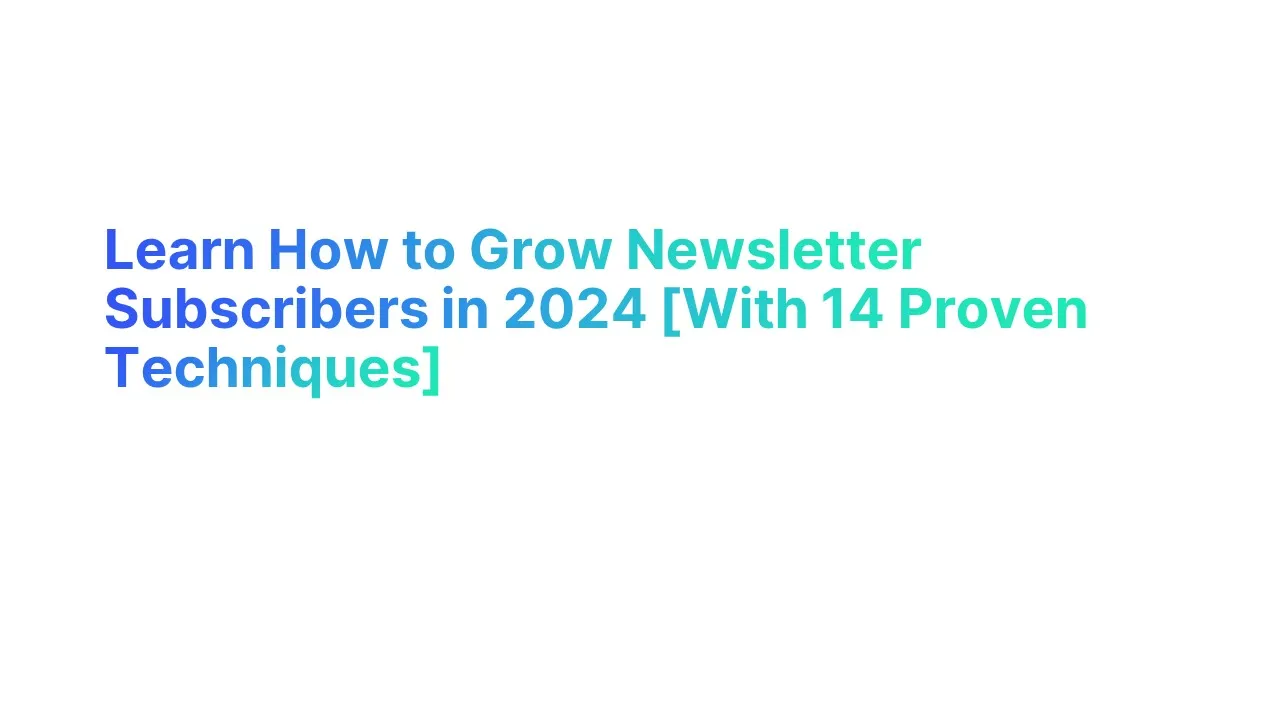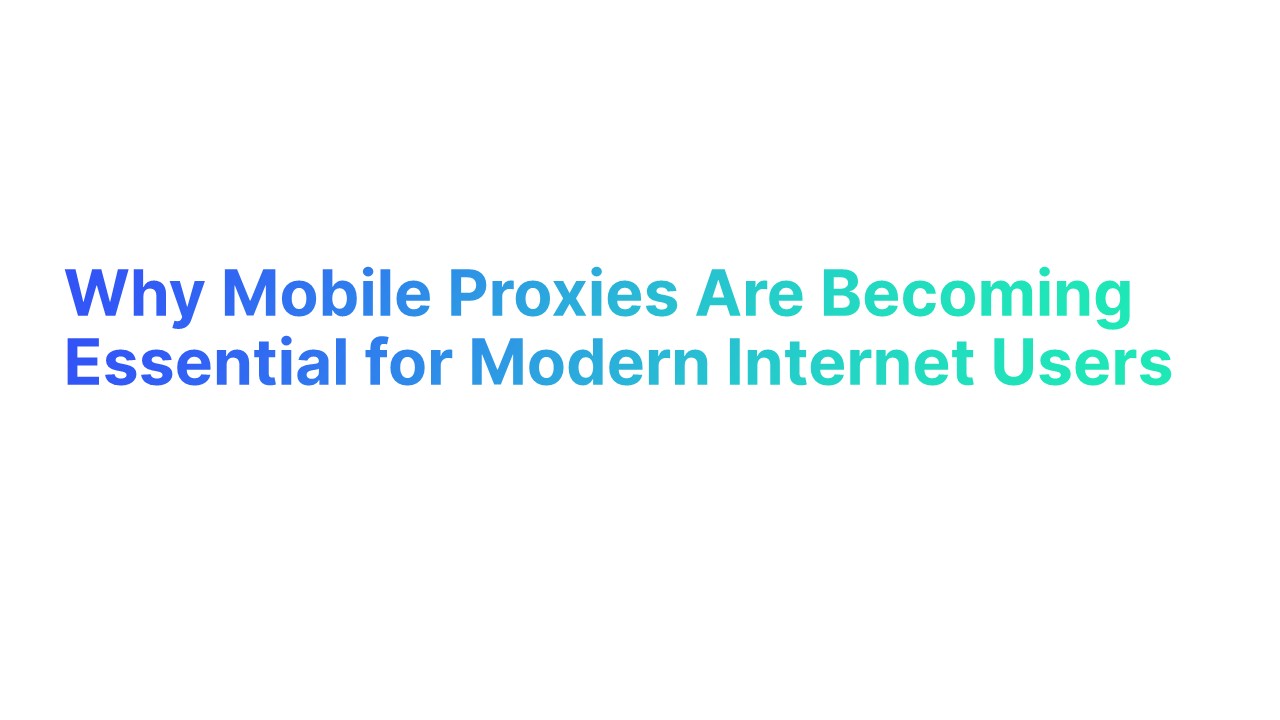Introduction to Growing Your Newsletter Subscribers

Growing your newsletter subscribers involves a multifaceted strategy centered on providing value and ease of access to potential subscribers.
Growing your newsletter subscribers requires a blend of content marketing, strategic planning, and technical optimization. Each element, from your web page and blog post to the signup form and marketing messages, should be crafted to not only attract website visitors but convert them into engaged and new subscribers.
This comprehensive approach ensures a steady growth of your newsletter subscriber base, leveraging both your content's value and strategic marketing techniques.
Importance of Newsletter Growth
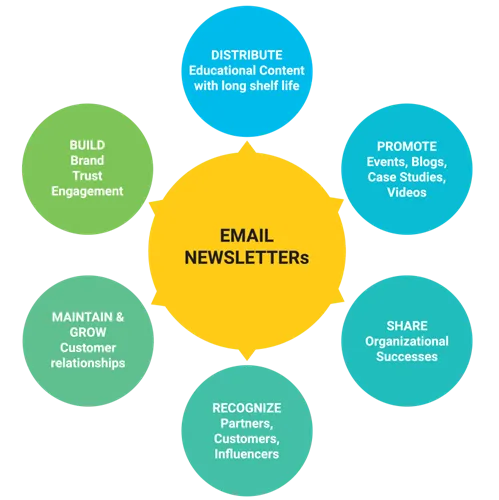
The growth of your newsletter subscriber is a critical component of your digital marketing strategy that can drive real business results. By expanding your email list, you're effectively increasing the potential reach and impact of your content and offers.
Direct Access to Interested Audience
- A larger newsletter list means a broader audience has shown interest in what you have to offer.
- Direct email communication bypasses the uncertainties of algorithm changes on social platforms, ensuring your message reaches your audience.
- Engage with your subscribers through personalized content that addresses their needs and interests, encouraging higher open and click-through rates.
Increased Conversion Opportunities
- Every new subscriber represents a potential lead that can be nurtured into a paying customer.
- According to a study by the DMA, the average return on investment for email marketing in 2019 was $42 for every $1 spent.
- Use targeted, behavior-based email campaigns to move subscribers along the sales funnel, from awareness to purchase.
Enhanced Customer Retention
- Newsletters keep your brand top-of-mind for existing customers, encouraging repeat business.
- It's 5-25X more expensive to acquire a new customer than to retain an existing one, reports Harvard Business Review.
- Deliver regular, valuable content that goes beyond sales pitches to include industry insights, customer stories, and helpful tips.
Valuable Feedback Loop
- Subscribers can serve as a valuable source of feedback on your content, products, or services.
- This direct line of communication allows for quick adjustments and improvements based on subscriber input.
- Include surveys, feedback forms, or direct reply options in your newsletters to gather insights and foster community.
Improved SEO and Website Traffic
- Regular newsletter content that drives subscribers back to your website can boost your SEO efforts and increase site traffic.
- More website visitors not only improve your site's authority in search engines but also increase opportunities for conversions and sales.
- Incorporate links to your latest blog posts, news, or product pages in your newsletter to encourage visits to your site.
14 Proven Techniques to Increase Newsletter Subscribers
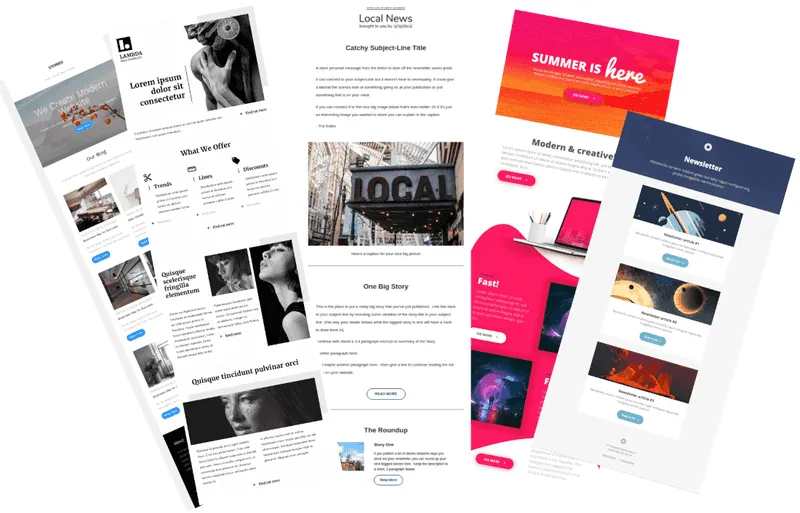
1. Optimize Your Landing Page
The first step in growing your newsletter subscribers is to ensure your landing page is perfectly optimized. A well-designed landing page acts as the gateway for potential subscribers, offering them a clear and compelling reason to join your email list.
What Makes an Optimized Landing Page
- Clear and concise messaging that highlights the benefits of subscribing.
- Visually appealing design that aligns with your brand.
- Minimal distractions to focus visitors on the sign-up form.
Why It’s Important:
- According to HubSpot, landing pages with targeted messaging are capable of increasing conversion rates by up to 300%.
- A focused call-to-action (CTA) can significantly reduce decision fatigue, making it easier for visitors to subscribe.

How to Optimize Your Landing Page
1. Clarify Your Value Proposition
Your landing page must immediately convey the value of subscribing to your newsletter. This involves crafting a headline that resonates with your target audience, highlighting the exclusive content, insider tips, or special offers they will receive as subscribers.
2. Simplify Design and Focus on the CTA
Keep the design clean and focused, with a clear call to action (CTA) that stands out. Use contrasting colors for your CTA button and keep it above the fold so visitors don't have to scroll to find it.
3. Include Testimonials or Social Proof
Adding testimonials or social proof can significantly boost trust. Showcase quotes from current subscribers or display a subscriber count if the number is impressive.
4. Speed Up Page Load Times
Optimize images, minify CSS and JavaScript, and leverage browser caching to improve page load times. A faster site can help reduce bounce rates and increase conversions.
5. Use A/B Testing
Continuously test different elements of your landing page, including headlines, CTA buttons, images, and form placements, to see what works best with your audience. Tools like Google Optimize can help facilitate these tests.
2. Use High-Converting Sign-Up Forms
The effectiveness of your sign-up form directly impacts your ability to capture newsletter subscribers. High-converting sign-up forms are not just about design; they're about creating a seamless, frictionless experience for your visitors.
Characteristics of High-Converting Sign-Up Forms
- Simple and straightforward form fields, asking only for essential information.
- Engaging copy that communicates what subscribers will receive.
- Strategic placement across your website—not just on the landing page.
Why This Strategy Works
- Reducing the number of form fields from 11 to 4 can increase conversion rates by up to 120%, as found in a study by Marketo.
- Forms placed within the upper portion of a landing page garner 50% more sign-ups than those placed lower down, indicating the importance of visibility.

How to Create High-Converting Sign-Up Form
1. Minimize Form Fields
Request only essential information such as the email address or perhaps the first name to personalize emails. Each additional field can decrease the likelihood of someone completing the form.
2. Craft Compelling Copy
Use persuasive copy in your form, explaining exactly what subscribers will gain by signing up. Make sure the benefits are clear and enticing.
3. Design for Visibility
Your form should be one of the first things visitors see on the page. Consider contrasting colors for the form and CTA button to make them stand out.
4. Implement Exit-Intent Popups
These popups appear when the user shows signs of leaving the page. Use a compelling message that offers a value-add for signing up at that moment, like a discount code or a free guide.
5. Enable Easy Sign-Up Through Social Media
Incorporate social login options to allow visitors to sign up with just a couple of clicks, leveraging their existing social media accounts. This can significantly reduce friction in the sign-up process.
6. Optimize for Mobile
Ensure your sign-up form is mobile-friendly, considering that a significant portion of web traffic comes from mobile devices. Test the form on various devices to ensure a smooth experience.
3. Offer a Lead Magnet
Offering a lead magnet is a powerful technique to increase newsletter subscribers by providing immediate value in exchange for their email address. A lead magnet can be anything from a free ebook, exclusive video, discount code, or an in-depth guide that your audience finds irresistible.
Why This Works:
- Lead magnets address specific needs or solve problems for your audience, making the subscription feel like a fair trade.
- According to MarketingProfs, companies offering lead magnets see a 10% or higher increase in conversion rates compared to those that don't.

How to Offer a Lead Magnet
1. Identify Your Audience’s Interests
Conduct market research or use insights from your website and social media analytics to understand the challenges and needs of your target audience. This will guide you in creating a lead magnet that truly resonates with them.
2. Create Valuable Content
Depending on your audience's preferences, develop a lead magnet that offers value. This could be an ebook, a webinar, a discount code for your services, or a comprehensive guide. The key is to ensure it's something they consider worth exchanging their email address for.
3. Design and Optimize Your Lead Magnet
Use professional tools or hire a designer to make your lead magnet visually appealing. For written content, consider employing a professional editor to ensure clarity and engagement.
4. Set Up a Dedicated Landing Page for Your Lead Magnet
This page should detail the benefits of the lead magnet and include a straightforward form for visitors to sign up and receive it. Ensure this page is optimized for conversions, with a compelling headline, engaging copy, and an easy-to-use sign-up form.
5. Promote Your Lead Magnet
Use your website, blog, social media channels, and any other marketing channels at your disposal to promote your lead magnet. Consider using targeted ads to reach a wider audience.
4. Leverage Social Media Platforms
Social media platforms are invaluable for reaching a wider audience and encouraging them to subscribe to your newsletter. By engaging with your followers and sharing valuable content, you can build a community around your brand and direct traffic to your sign-up forms.
Why It’s Effective:
- Social media gives you direct access to a vast audience. With over 3.6 billion people using social media worldwide (Statista, 2020), the potential reach is enormous.
- Engaging content on social media can go viral, significantly increasing exposure to your newsletter sign-up.
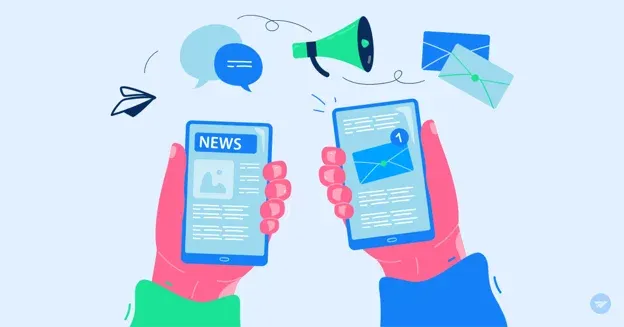
How to Leverage Social Media
1. Develop a Consistent Posting Schedule
Regularly share engaging, valuable content on your social media platforms to keep your audience engaged. Use a content calendar to plan your posts in advance.
2. Use Visuals and Videos
Posts with images or videos tend to get more engagement on social media. Use high-quality visuals that align with your brand and the message you want to convey about your newsletter.
3. Engage Directly With Your Followers
Respond to comments, messages, and mentions to build a community around your brand. Engagement can increase the visibility of your posts and encourage more sign-ups.
4. Run Targeted Social Media Ad Campaigns
Use the advertising tools provided by platforms like Facebook and Instagram to create targeted campaigns aimed at your ideal subscriber. Tailor your messaging to highlight the benefits of signing up for your newsletter.
5. Host Live Sessions or Q&As
These interactive sessions can be a great way to connect with your audience, provide value, and softly promote your newsletter sign-up in the process.
6. Include a Sign-Up Link in Your Bio
Most social media platforms allow you to include a link in your profile bio. Use this space to link directly to your newsletter sign-up page or landing page.
5. Run Targeted Social Media Ads
Using targeted social media ads is an effective way to increase your newsletter subscribers. These ads allow you to reach individuals beyond your current followers, targeting users based on their interests, behaviors, and more.
Why This Works:
- Social media platforms like facebook page or google have vast amounts of user data, enabling precise targeting. Ads can be customized to appear to those most likely interested in your content, increasing the chance of subscription. These Ads
- According to a report by eMarketer, social media ad spend is expected to increase, reflecting its effectiveness in reaching target audiences.

How to Implement Running Targeted Social Media Ads
1. Define Your Audience
Start by clearly identifying who you want to target. Use the demographic, interest, and behavior targeting options provided by social media platforms to specify your ideal audience. Consider factors like age, location, interests, and online behaviors that align with your newsletter content.
2. Set Clear Objectives
Determine what you want to achieve with your ads. For newsletter subscriptions, your objective could be to increase website traffic or directly increase conversions (sign-ups). Setting clear objectives helps in choosing the right ad format and content.
3. Design Engaging Ad Creatives
Create visually appealing ads that stand out in the social feed. Use high-quality images or videos, compelling headlines, and a clear call to action (CTA) that directs users to your newsletter sign-up page.
4. Optimize Landing Pages for Conversion
Ensure the landing page linked from your ad is optimized for conversions. It should load quickly, display well on mobile devices, and make the sign-up process as simple as possible.
6. Include Testimonials or Social Proof
Incorporating testimonials or social proof on your sign-up page or within your promotional content can significantly boost your newsletter subscriptions. Seeing that others have benefited from your content builds trust and credibility.
Why It’s Effective:
- Social proof leverages the psychological tendency to follow the actions of others. According to Nielsen, 92% of people will trust a recommendation from a peer, and 70% of people will trust a recommendation even if it’s from someone they don’t know.
- Testimonials and other forms of social proof like subscriber counts or badges (e.g., "As featured in...") can alleviate doubts new subscribers may have.

How to Include Testimonials or Social Proof
1. Gather Testimonials
Reach out to your most engaged email subscriptions and ask for testimonials about your newsletter. Specifics about how your newsletter has provided value or solved a problem are especially compelling.
2. Showcase Subscriber Counts
If you have a large number of subscribers, mention this as a form of social proof. Phrases like "Join 20,000+ subscribers" can be very persuasive.
3. Display Badges or Recognitions
If your newsletter or business has been featured in notable publications or received awards, display these recognitions prominently near your sign-up form.
4. Use Visuals
Whenever possible, include photos or logos to add authenticity to your testimonials and recognitions.
7. Create Engaging Content
Content that resonates with your audience encourages not only current subscriber engagement but also attracts new subscribers through shares and recommendations.
Why Engaging Content Matters:
- Engaging content drives interaction, increasing the likelihood of your newsletter being shared across social networks and word of mouth, thereby reaching a broader audience.
- A study by Content Marketing Institute shows that 72% of marketers have increased their number of engaged audience members through content marketing.

How to Create Engaging Content
1. Conduct Surveys and Polls
Directly ask your subscribers what topics they're interested in or what problems they need solved. Use this feedback to tailor your content.
2. Analyze Engagement Data
Look at which previous newsletter issues had the highest open and click-through rates. This can give you insights into the types of content that resonate most with your audience.
3. Mix Content Types
Incorporate a variety of formats such as text, video, infographics, and interactive polls or quizzes to keep your newsletter fresh and engaging. Different formats can cater to different preferences within your audience.
4. Feature Guest Contributors
Invite experts or influencers in your field to contribute content. This not only adds credibility to your newsletter but also diversifies the voices and perspectives presented.
5. Research Thoroughly
Ensure that every piece of content you create is well-researched and provides real value. Addressing your audience's questions and challenges can make your newsletter an indispensable resource.
6. Professional Presentation
Use high-quality images, a clean layout, and professional language. Engaging content isn't just about what you say but also how you say it.
7. End With a Question
Prompt subscribers to think by ending your newsletter with a thought-provoking question related to the content. Encourage them to reply with their thoughts, fostering a sense of community.
8. Call-to-Action for Feedback
Regularly invite your subscribers to provide feedback on what they would like to see more (or less) of in your newsletter. This not only engages them but also gives you valuable insights for future content planning.
8. Utilize Content Upgrades
Content upgrades are targeted bonus content offered within or at the end of your regular content. They require the reader to subscribe to access the additional content, making them an effective tool for growing your newsletter subscribers.
Why Content Upgrades Work:
- They provide immediate value to the reader, offering something extra in exchange for their email address.
- By being highly relevant to the content the reader is already engaging with, content upgrades see higher conversion rates than generic sign-up prompts. According to Leadpages, content upgrades can increase conversion rates by up to 785%.
How to Implement Content Upgrades of Your Blog Post
1. Identify Popular Content
Look at your website analytics to find your most popular content. These are prime candidates for content upgrades since they already attract a significant audience.
2. Create Relevant Upgrades
Develop upgrades that complement or expand upon the original content. This could be a detailed guide, checklist, video tutorial, or an exclusive interview.
3. Make It Easy to Access
Include a simple sign-up form directly within or at the end of the content that triggers the content upgrade delivery. Ensure the process is straightforward and user-friendly.
4. Promote Your Upgrades
Use social media, your website, and other channels to promote your content upgrades. Highlight the exclusive nature of the bonus content to encourage sign-ups.
9. Implement Exit-Intent Popups
Exit-intent popup is a strategic tool designed to capture the attention of users who are about to leave your site. By presenting them with a compelling offer or message just as they're about to exit, you can convert a portion of these departing visitors into newsletter subscribers.
Why Exit-Intent Popups Are Effective:
- They act as a final engagement point that can capture leads that would otherwise be lost. According to OptinMonster, exit-intent popups have successfully increased conversion rates by up to 600% in some cases.
- These popups provide a non-intrusive way to present offers or subscriptions, as they only appear when a user is about to leave the site.

How to Implement Exit-Intent Popups
1. Use Engaging Copy and Design
Create popups that are visually appealing and contain concise, compelling copy that communicates the value of subscribing to your newsletter.
2. Offer Something Valuable
Whether it’s a discount, exclusive content, or a free guide, the offer should be something enticing enough to persuade users to leave their email address.
3. Make It Easy to Close the Popup
Ensure that users can easily dismiss the popup if they're not interested. Forcing users to interact with the popup can create frustration and negatively impact their experience.
4. Test and Optimize
Regularly test different designs, offers, and copy to see what works best. Use A/B testing to refine your strategy and maximize conversion rates.
10. Host Webinars or Live Events
Hosting webinars or live events is a powerful way to engage with your audience directly, establish authority, and grow your newsletter subscribers.
These events offer valuable content that can attract registrations from interested users who are likely to subscribe to your newsletter for more insights.
Why Webinars and Live Events Attract Subscribers
- They provide an opportunity for real-time engagement, allowing you to interact with your audience, answer questions, and build a community around your brand. According to GoToWebinar, webinars retain 40% of viewers’ attention, making them highly engaging.
- Offering exclusive access or content to newsletter subscribers as part of the event can motivate attendees to subscribe.

How to Host Successful Webinars or Live Events
1. Choose Relevant Topics
Select topics that are not only relevant to your audience’s interests but also showcase your expertise and the value of your newsletter content.
2. Promote Your Event
Use your website, social media, email marketing, and even paid advertising to promote your event. Highlight the unique value attendees will gain by participating.
3. Collect Email Addresses at Registration
Make email submission part of the registration process. Clearly state that registrants will also receive your newsletter, providing a checkbox for consent.
4. Deliver Exceptional Value During the Event
Ensure your content is informative, engaging, and well-presented. Follow up the event with an email that includes additional resources, a replay of the event, and a prompt to subscribe if they haven’t already.
5. Encourage Sharing
At the end of your webinar or event, encourage attendees to share the event on social media or with friends who might be interested, expanding your reach.
11. Collaborate with Other Brands
Collaborating with other brands can open up new avenues for newsletter subscriber growth by tapping into each other's audiences. This strategy can be particularly effective when the brands share similar target markets but are not direct competitors.
Why Brand Collaborations Work:
- By partnering with another brand, you gain access to their audience, which might not have discovered your newsletter otherwise. This can significantly increase your subscriber base.
- A collaboration can enhance credibility as each brand leverages the trust and authority they've built up with their audience. Nielsen reports that 92% of consumers trust earned media, such as recommendations from friends and family, above all other forms of advertising.
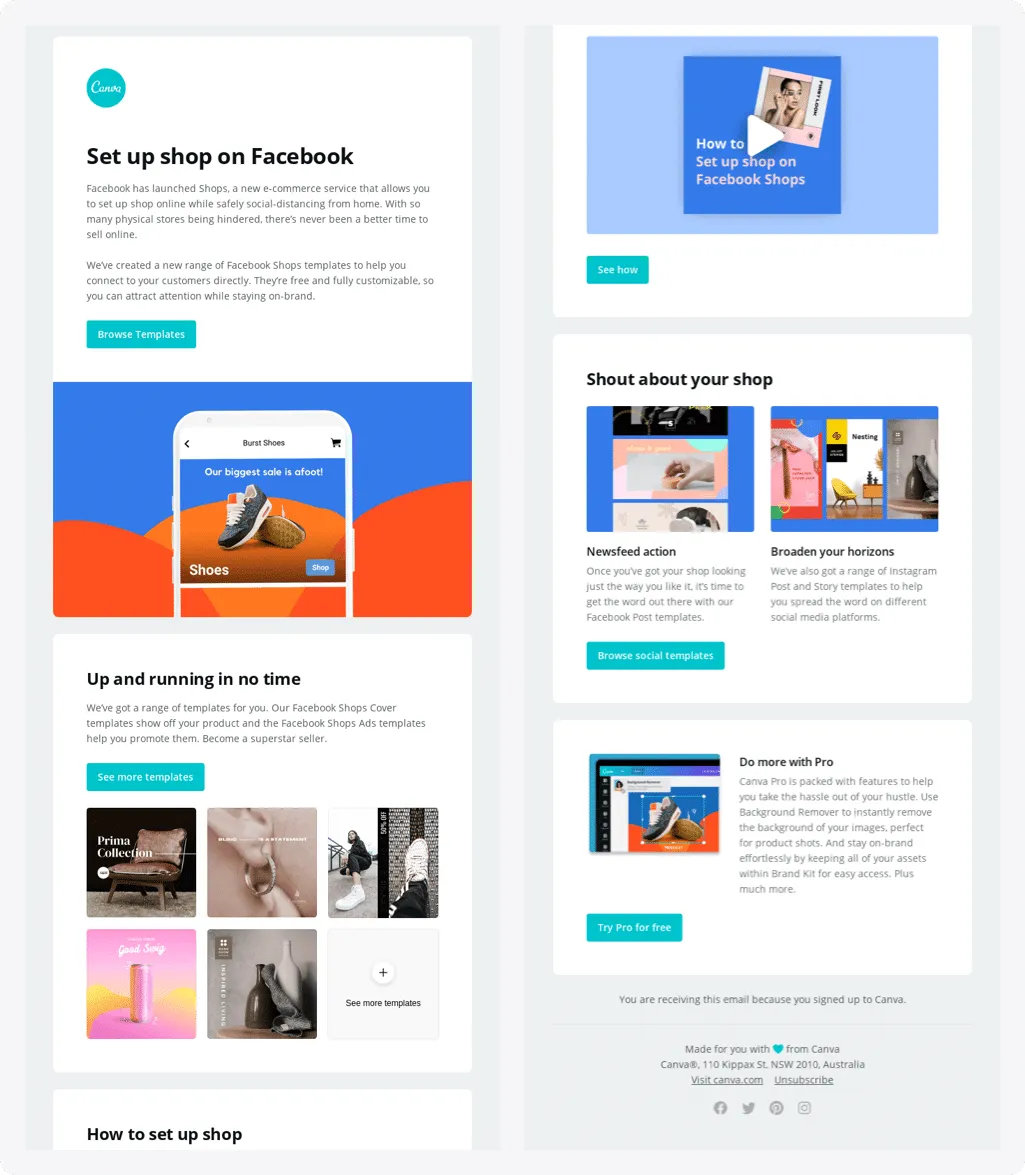
How to Implement Brand Collaborations
1. Identify Complementary Brands
Look for brands that offer products or services that complement yours and share a similar audience demographic.
2. Co-create Content
Work together to create content that is valuable to both audiences, such as webinars, joint blog posts, or co-hosted events, and promote this content to your respective newsletters.
3. Cross-Promote
Agree to promote each other's newsletters in your communications, ensuring that the value proposition is clear to encourage sign-ups.
4. Measure and Share Results
Keep track of the collaboration's impact on your newsletter growth, and share these insights with your partner brand. This can help refine strategies for future collaborations.
12. Email Signature Promotion
An often-overlooked strategy, promoting your newsletter in your email signature, is a simple yet effective way to consistently reach a new audience. Every email sent is an opportunity to gain a new subscriber.
Why Email Signature Promotions Are Effective:
- Your email signature is a non-intrusive way to promote your newsletter. Recipients who are already engaging with your emails may be more inclined to subscribe.
- This method utilizes existing communications channels, requiring no additional budget. It’s a low-effort tactic with the potential for high returns.

How to Implement Email Signature Promotion
1. Design a Compelling Signature
Use a tool to create an attractive email signature that includes a brief call to action (CTA) for your newsletter. Make sure the design is mobile-friendly.
2. Include a Direct Link
Embed a link in your signature that directs recipients straight to your newsletter sign-up page. The fewer steps involved, the better.
3. Track Clicks
Use UTM parameters or a dedicated landing page to track how many subscribers are gained through your email signature. This helps measure effectiveness and ROI.
4. Update Regularly
Keep the message in your signature fresh by updating it periodically with new offers or highlights from your newsletter content.
13. Guest Post on Relevant Sites
Guest posting on relevant sites within your industry can significantly enhance your visibility and direct traffic to your newsletter signup page. This strategy not only drives more subscribers but also establishes your authority in your field.
Why Guest Posting Is Effective:
- Guest posts allow you to tap into the established audience of the host site, bringing your expertise and value proposition to new potential email subscribers.
- According to a study by Social Marketing Writing, 62.96% of people perceive blogs with multiple authors to be more credible. Contributing quality content can leverage this credibility to grow your subscriber base.

How to Implement Guest Posting
1. Identify Target Sites
Look for blogs or online communities that share your target audience but aren't direct competitors. Focus on those with high engagement and a solid readership.
2. Pitch Relevant, Valuable Content
Your guest post should offer unique insights or valuable information that addresses the host site's audience's needs. Tailoring your pitch increases the likelihood of acceptance.
3. Include a Call-to-Action
Most sites will allow you to include a bio or footer where you can place a call-to-action (CTA) directing readers to your newsletter signup page. Make the CTA compelling to encourage clicks.
4. Promote Your Guest Post
Once published, share the post across your social media channels and with your existing email subscribers to maximize its reach.
14. Offer Exclusive Subscriber Benefits
Providing exclusive benefits to your newsletter subscribers is a powerful incentive for new signups. These benefits could range from access to premium content, discounts, or entry into online contests exclusive to email signups.
Why Offering Exclusive Benefits Works:
- Exclusive offers create a sense of belonging to a special group, which can be a strong motivator for new subscribers. A report by the Content Marketing Institute indicates that email newsletters rank as the top method content marketers use to nurture their audience.
- This strategy also encourages loyalty among existing subscribers, reducing churn rates and fostering a growing, engaged online community.
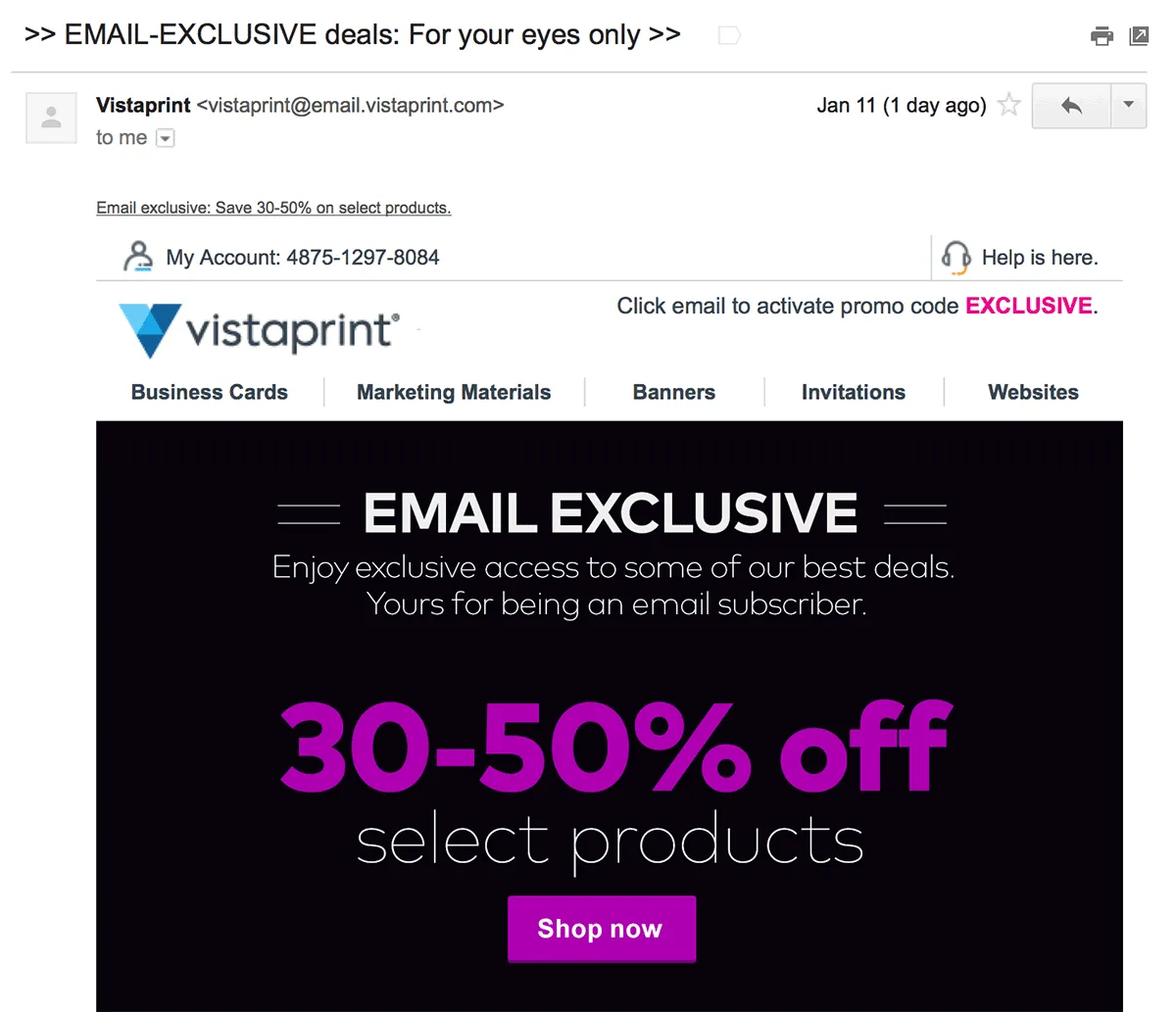
How to Implement Exclusive Subscriber Benefits
1. Identify Attractive Offers
Understand what your audience values most. This could be early access to products, special discounts, or content that is not available elsewhere.
2. Promote Benefits Across Channels
Highlight these exclusive benefits on your website, in guest posts, and on social media. Use phrases like "Subscribe for exclusive benefits" to attract attention.
3. Create a Dedicated Signup Page
Your signup page should detail the exclusive benefits subscribers will receive. This clarity can significantly increase the conversion rate.
4. Engage in Online Contests
Hosting an online contest for new and existing subscribers can create buzz and encourage signups. Ensure the contest is promoted widely and tied back to the value of your newsletter content.
How to Get People to Sign Up Efficiently

Efficiently getting people to sign up for your newsletter involves leveraging both the design of your sign-up process and the value proposition of your content. The goal is to make the process as simple and compelling as possible.
Optimize the Sign-Up Process:
- Simplify Forms: Reduce the number of fields in your sign-up form to the bare minimum, typically just an email address. A study by HubSpot showed that reducing the number of form fields from four to three can increase conversion rates by 25%.
- Use Strategic Placement: Place sign-up forms prominently on your website, including the homepage, blog posts, and as part of the footer. Pop-up forms triggered by user behavior, like spending a certain amount of time on a page, can also be effective.
Highlight the Value Proposition:
- Clearly Communicate Benefits: Be explicit about what subscribers will receive, whether it's exclusive content, early access to products or sales, or valuable insights and tips. This clarity can significantly boost sign-up rates.
- Use Social Proof: Incorporate testimonials or subscriber counts near your sign-up form to build trust and validate the decision to subscribe.
How to Retain Your Newsletter Subscribers

Retaining your newsletter subscribers requires ongoing effort to ensure the content remains relevant, valuable, and engaging. It's about building a relationship with your subscribers that keeps them looking forward to each new issue.
Deliver Consistent Value:
- Segment Your Audience: Use subscriber data to segment your audience and tailor content to different groups' interests. Personalized emails can lift transaction rates and revenue per email six times higher than non-personalized emails according to Experian.
- Keep Content Fresh: Regularly introduce new content formats, topics, or guest contributors to keep the newsletter interesting and engaging. Monitoring open and click-through rates can guide you on what content resonates most with your subscribers.
Engage with Your Subscribers:
- Encourage Feedback: Invite subscribers to share their thoughts on the newsletter content, either through direct replies or via surveys. This not only provides valuable insights but also makes subscribers feel heard and valued.
- Implement Re-engagement Campaigns: For subscribers who haven’t interacted with your newsletter in a while, consider sending a special re-engagement email with a compelling reason to start opening your emails again, such as an exclusive offer or a summary of what they’ve missed.
Final Thoughts on Increasing Newsletter Subscribers
To grow your newsletter subscribers, it’s crucial to keep things simple and focus on what works. As an online business owner, start by making your signup process straightforward and clear.
Highlight the value of your newsletter directly on your signup page—tell potential subscribers exactly what they’ll gain by joining. Whether it’s exclusive offers, valuable insights, or the latest news in your industry, make sure it’s something they can’t resist.
Remember, the key is to communicate clearly, make signing up easy, and consistently deliver content that keeps your audience engaged.

